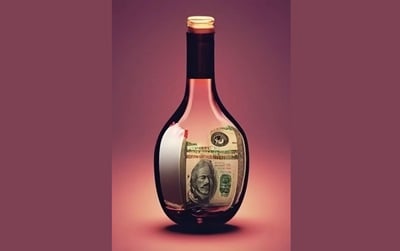It’s fascinating to peek into the economics behind the prices on a bar or restaurant’s wine list. The markup strategy certainly seems to follow a logical pattern, with cheaper wines often bearing a higher percentage markup than their pricier counterparts. This reflects the balance between affordability and quality that establishments aim to strike. In order to under the price, it is important to consider the wine as well as the ambiance, service, and overall experience which are all integral parts of the price.
For a bar or restaurant owner to put a price on the glass or bottle of wine, they consider factors that help diners appreciate the value they’re receiving beyond just the liquid in their glass.
It’s all part of the intricate dance between cost, quality, and experience that makes dining out such a rich and multifaceted experience.
Shock and Awe
1. Jug wine
If you’re opting for something budget-friendly, expect a markup of 350–400%. It might seem steep, but it’s the price for convenience and affordability.
2. Popular- and mid-premium wine
These bottles usually see markups of around 300–350%. They strike a balance between quality and cost, making them popular choices for many diners.
3. Super-premium wine
Looking for something a bit fancier? Prepare for markups in the range of 250–300%. These wines boast higher quality and a higher price tag to match.
4. Luxury wine
For those special occasions or discerning palates, luxury wines typically have markups below 250%. While still a splurge, the markup reflects the exclusivity and prestige of these bottles.
Graduated Markups
This pricing strategy, known as graduated markup, means cheaper bottles tend to have higher markups, while pricier options are marked up more modestly. The markup at bars and restaurants covers expenses such as rent, utilities, staff wages, and other operational costs. The markups vary based on location, the ambiance of the space, the quality of the service, and the perceived value of the wine to the customer.
Pay for the Ambiance
The wine markup includes the “experience” of having it served to you, in an elegant glass, in a pleasant, glamorous (or not) environment by a sommelier or other knowledgeable staffer.
Storage and Handling
Bars and restaurants invest in suitable storage facilities and equipment to ensure the wines are served and kept at optimal conditions. Included in these costs are the maintenance of appropriate temperatures and humidity levels to preserve the quality of the wine, as well as handling and transportation of wine from suppliers, to the establishment and then to the customer.
Selection and Curation
Many bars and restaurants pride themselves on offering a curated selection of wines to complement their menu and cater to the tastes of their clientele. This may require extensive research, tasting sessions, and ongoing management of the wine list, adding to the overall cost.
Economy of Scale
Bars and restaurants purchase wine in larger quantities than an individual consumer; however, they may not benefit from some benefits of the “economy of scale” as experienced by large retailers or wholesalers. This results in pricing that may not be as favorable from the suppliers and impact on the costs which are passed on to the guest.
Quality and Prestige
Some establishments focus on offering high-quality or prestigious wines that come with a premium price tag due to their reputation, rarity, or production methods. Customers are willing to pay more for these wines because of their perceived value and exclusivity.
Licenses and Regulations
Restaurants and bars often have to obtain licenses to sell alcohol, which comes with associated fees and taxes. Compliance with regulations, including age verification and responsible serving practices, also adds to the operational costs.
Behind the Bar
Overall, while wines at bars and restaurants may seem expensive compared to retail prices, the cost reflects not only the quality of the wine but also the experience and services provided by the establishment.
Wine or Spirits
While the markup on wine might seem hefty, it’s quite modest compared to the markup on liquor. Consider this scenario: A restauranteur sells five $8 cocktails, each taking five minutes to craft, with an 80% profit margin, totaling a $32 profit. Or, the manager could opt to sell just one $150 bottle of wine, taking only two minutes to uncork and pour, with a 65% profit margin, resulting in a $97.50 profit. The choice becomes clear when you see the numbers. Not only does selling wine offer a decent profit margin, but it also requires less time and effort, ultimately benefiting the restaurant’s bottom line.
Be Thoughtful
The next time you’re perusing the wine list, remember that behind every price tag lies a carefully calculated markup that ensures both profitability and customer satisfaction. Cheers!
© Dr. Elinor Garely. This copyright article, including photos, may not be reproduced without written permission from the author.
(eTN): Vintage Vigilance: Navigating the Pour – Deciphering Wine Prices | re-post license | post content























